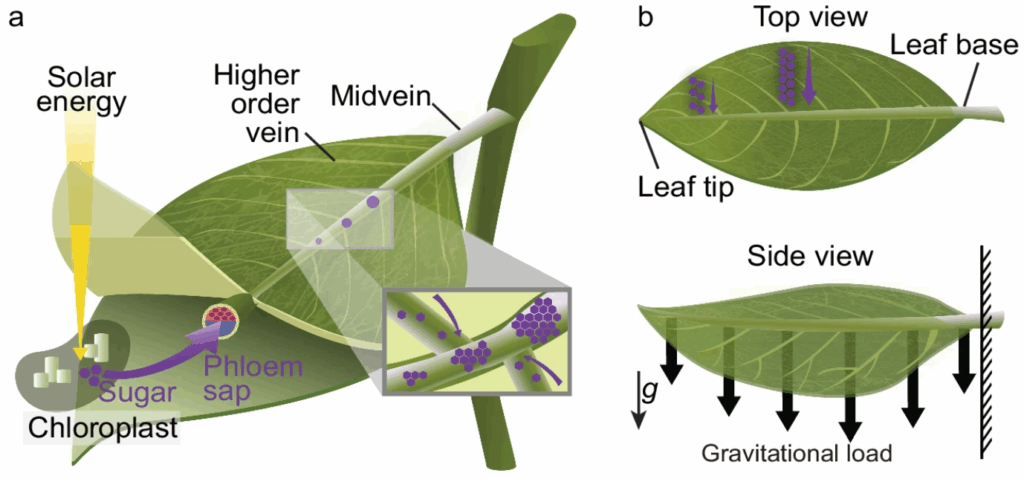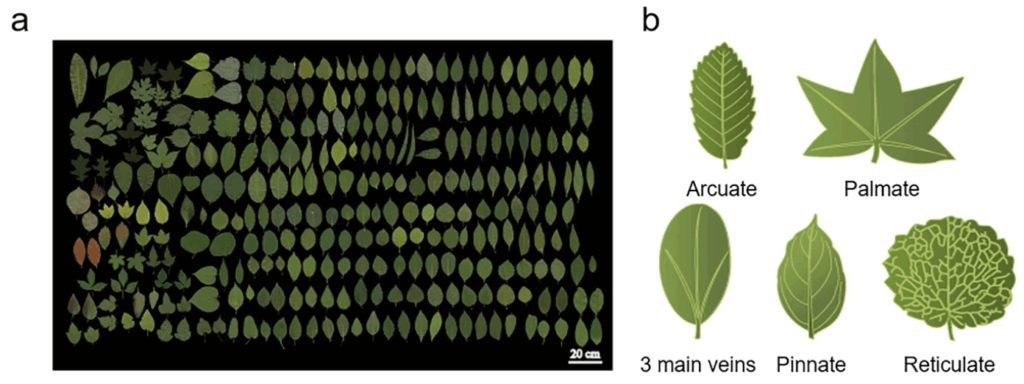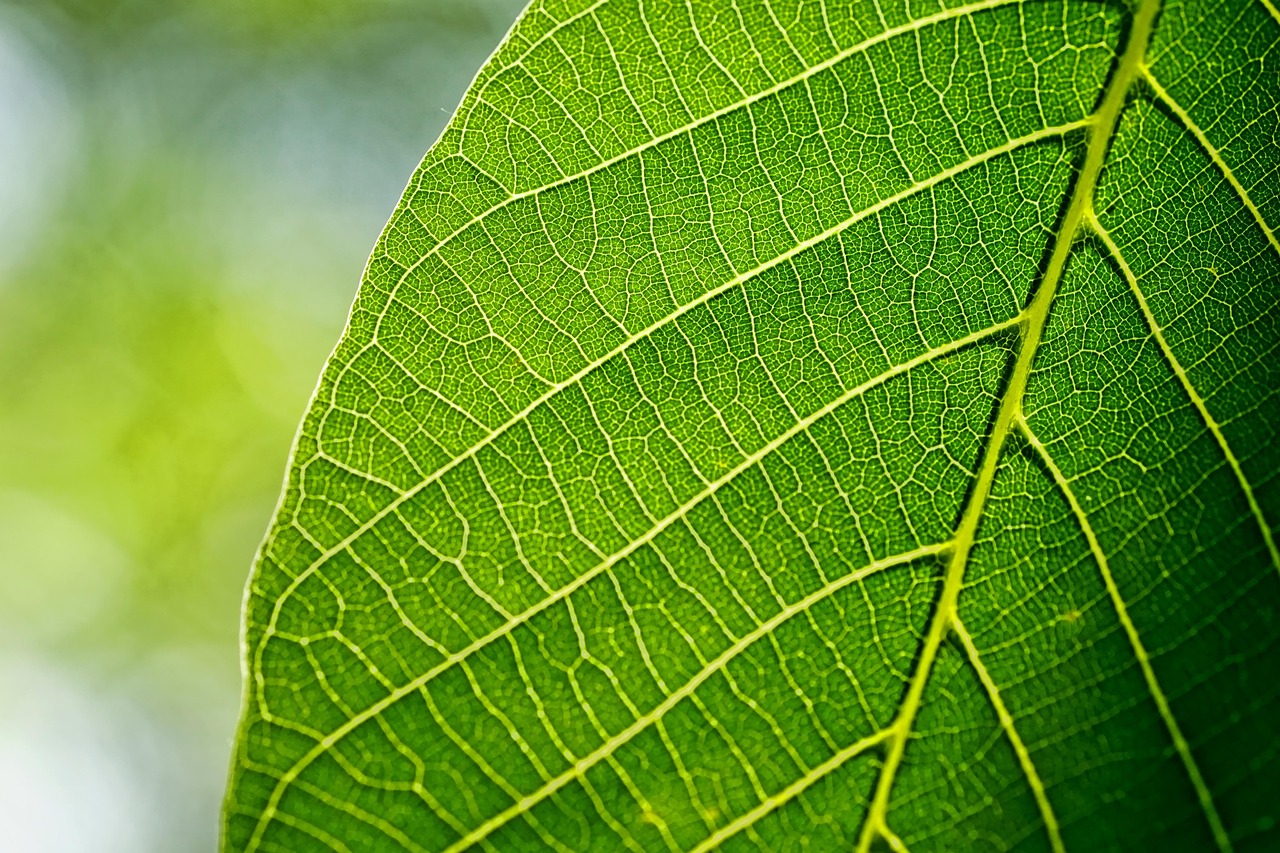Picking up a fallen leaf, our eyes are naturally drawn to the thick vein running through its center. Called the midvein, this vein gradually narrows toward the leaf tip, eventually fading into a delicate network almost invisible to the naked eye. While this may seem ordinary, it raises a curious question: why does the vein become thinner? Wouldn’t it transport water and nutrients more efficiently if it were thicker all the way? In reality, veins are not merely conduits but also pillars that support the entire leaf. In other words, veins are both pipelines and skeletons, and their thickness and shape are determined by the trade-off between transport and support. A recent study provides a clear answer to this everyday question, using concrete numbers and models.
Reference: A trade-off between transport and mechanics determines plant leaf vein architecture
Research Background ―― The Dual Function of Leaf Veins and the Design Dilemma
Plant veins serve two roles: (1) xylem (vessels) deliver water and minerals upstream to the leaf, and phloem (sieve tubes) return sugars produced in the leaf back to the base, functioning as a transport route; (2) they also act as structural material that spreads the lamina and resists self-weight and external forces such as wind and rain.
If the vein thickens, the increase in cross-sectional area drastically reduces hydraulic resistance (as predicted by Poiseuille’s law, roughly proportional to the fourth power of radius), minimizing pressure loss. Simultaneously, the increase in the second moment of area enhances bending stiffness, making the leaf more resistant to deflection and buckling. On the other hand, thickening requires lignified tissue, adds mass, and increases the proportion of leaf area occupied by veins, thereby reducing the relative area available for photosynthesis—this is the problem of “dead space.” Conversely, thinner veins allow for lighter expansion but increase transport loss and reduce structural stability.
This tug-of-war between conflicting conditions has long been considered the core “design problem” governing vein thickness, branching angle, and taper from tip to base. The reported study tested this assumption using both data (comparisons of 147 species) and theory (transport and mechanical models), clarifying functional allocation (tip = transport priority / base = support priority). Furthermore, the study systematized factors linking form and function, such as the correlation between leaf shape (width distribution) and midvein diameter, and the trade-off between vein occupancy and photosynthetic opportunity, which can be positioned as new knowledge provided by this work.

Research Methods ―― Comparing Many Leaves
The study systematically compared midvein shapes of 147 species with diverse morphologies and ecological backgrounds. Samples covered a wide taxonomic range from tropical to temperate plants, with midvein lengths spanning 30–307 mm. Using digital image analysis, the researchers measured leaf width distribution along the midvein with high resolution and quantified diameter changes at each position. This established a statistical basis for evaluating the relationship between leaf shape and midvein cross-section.
Two theoretical models were then constructed:
- Transport efficiency model: described the inflow of sugars into the midvein proportional to leaf width and their downstream flow to the base, deriving an ideal cross-sectional distribution that minimizes pressure loss.
- Mechanical model: treated the midvein as a beam supporting leaf self-weight and wind loads, evaluating the cross-sectional dimensions needed to resist bending and buckling.
These models were designed on the premise that the “transport optimum” and “mechanical optimum” do not necessarily coincide. Comparing these theoretical predictions with actual observations revealed which functions are prioritized in different parts of the leaf.

Results and Discussion ―― Leaf Veins as Clusters of Optimal Solutions for Transport and Support
The analysis demonstrated that the shape of leaf veins can be understood as a switching of functional priorities within a single leaf. The main findings are as follows:
- Leaf tip: Observed midvein taper closely matched the profile predicted by the transport optimum. Here, photosynthates from lateral veins continuously merge into the midvein and flow to the base, so minimizing pressure loss and accommodating increasing flow are prioritized. From a mechanical perspective, however, this part represents a form of overinvestment, not structurally optimal.
- Leaf base: The base was closer to the mechanical optimum, where structural stability takes precedence. To withstand self-weight and external forces (gravity, wind), the midvein must act as a beam, and bending stiffness is prioritized. Consequently, efficiency of translocation is somewhat compromised.
Thus, tip = transport priority / base = support priority—a superposition of local optima—was confirmed across many of the 147 species. Matching models and data showed that predicted “optimal midvein profiles” based on leaf width distribution were reproducible across taxa, confirming that different functional rules govern tip and base. Exceptions were noted, where specific ecological or morphological adaptations (e.g., thick leathery leaves, strong wind environments) might bias the pattern.
Thickening veins provides gains in both transport and support, but it also incurs construction and maintenance costs and enlarges the non-photosynthetic “dead space” within the lamina. This occupancy can reach up to about 50% of the leaf area, indicating that “thicker is always better” is not true. This study, against such cost–benefit considerations, supports the view that functional priorities shift by location, based on both comparative data and theory.
What Could This Be Used For?
This discovery offers a perspective of interpreting natural forms as design blueprints. The shape of veins is not simply “the thicker the better” or “thin is enough,” but rather the optimal solution from balancing function and cost. Even from casual observations of leaves, one can see differences in the priorities of transport and support.
From an applied perspective, the design principle of veins can be transferred into biomimetics. Examples include lightweight yet strong construction materials, efficient fluid transport systems, and cooling devices. By mimicking natural algorithms, new engineering technologies may emerge. The key lies not in a single optimum but in combining different local optima by region. For instance, assigning variable-section conduits responsive to flow increase at the tip and beam designs prioritizing bending stiffness at the base embodies a functional partitioning design principle, directly applicable to creating lightweight, strong, and low-loss artificial systems.
onclusion
- Leaf veins serve dual roles as “pipelines” and “skeletons,” and their shapes are determined by balancing conflicting demands.
- Comparisons across 147 species and theoretical models revealed that the tip prioritizes transport, while the base prioritizes support, forming a superposition of local optima.
- Indicators linking form and function, such as scaling between leaf size and midvein diameter, and the cost of non-photosynthetic area, were organized.
- This knowledge not only provides a new lens for natural observation but also hints at future engineering applications.
Next time you pick up a fallen leaf, notice the changes in vein thickness and feel the algorithm of nature hidden within. The familiar green may appear as a design blueprint.す。



コメント